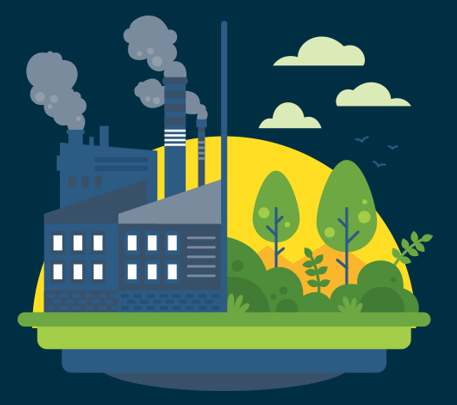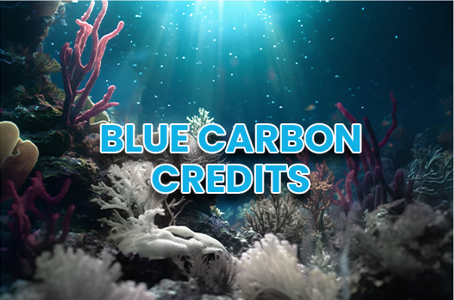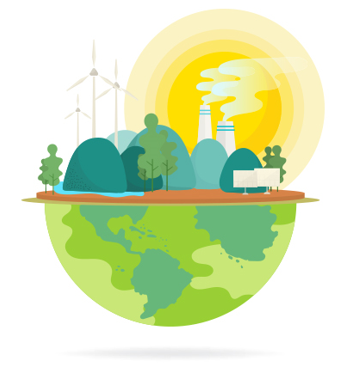
What Do You Mean By Carbon Credit & Carbon Offset?
“Carbon Credit” refers to a certificate that represents the right to emit one tonne of carbon dioxide or the mass of another greenhouse gas with a carbon dioxide equivalent (tCO2e) to one tonne of carbon dioxide. Carbon credits are part of an approach to emissions trading, where a government or another regulating body sets a cap on the amount of greenhouse gases that can be emitted, and companies or other groups are issued carbon credits that represent the right to emit a certain amount of those gases. The total amount of credits cannot exceed the cap, meaning that total emissions are limited.
“Carbon Offset” is a reduction in emissions of carbon dioxide or greenhouse gases made in order to compensate for or to offset an emission made elsewhere. Offsets are typically achieved through financial support of projects that reduce the emission of greenhouse gases in the short- or long-term. A common project type is renewable energy, such as wind farms, biomass energy, or hydroelectric dams. Others include energy efficiency projects, the destruction of industrial pollutants or agricultural byproducts, destruction of landfill methane, and forestry projects.
DIFFERENCE BETWEEN CARBON CREDIT & CARBON OFFSET
| Aspect | Carbon Credit | Carbon Offset |
|---|---|---|
| Definition | A carbon credit is a certificate or permit which represents the legal right to emit one tonne of carbon dioxide or an equivalent amount of a different greenhouse gas. It's a part of a cap-and-trade system. | A carbon offset represents a reduction in emissions of carbon dioxide or other greenhouse gases made to compensate for emissions made elsewhere. |
| Origins in Climate Policy | Carbon credits are a key component of national and international emissions trading schemes to reduce industrial greenhouse gas emissions. | Carbon offsets are a form of trade. When you buy an offset, you fund projects that reduce greenhouse gas emissions. |
| Market Mechanism | Typically operates within a mandatory cap-and-trade system, where businesses are allocated or purchase carbon credits within an established limit or cap on emissions. | Operates within a voluntary market, where individuals or companies purchase offsets to mitigate their own emissions for various reasons, often to improve their environmental standing. |
| Regulation and Standards | Carbon credits are often subject to strict regulation and standards, especially within compliance markets, to ensure that they represent actual reductions in emissions. | Carbon offsets may be verified by third-party organizations to ensure that the emission reductions are real, measurable, permanent, and additional to any that would occur without the project. |
| Measurement | Measured in tonnes of CO2-equivalent emissions. One carbon credit represents one tonne of CO2-equivalent emissions reduced or removed from the atmosphere. | Also measured in tonnes of CO2-equivalent emissions. One carbon offset represents one tonne of CO2-equivalent emissions that has been reduced or removed. |
| Purchasing and Usage | Carbon credits can be bought and sold on carbon markets, with prices influenced by supply and demand dynamics. They are often used by companies that are required to maintain their emissions within a certain quota. | Carbon offsets can be purchased by anyone looking to compensate for the emissions they cannot eliminate. They are not limited by a cap and can be used to reach different kinds of carbon neutrality or net-zero goals. |
| Examples of Projects | Projects that can generate carbon credits include renewable energy (like wind or solar power), methane capture from landfills, and reforestation. | Projects that can generate carbon offsets include reforestation, energy efficiency upgrades, methane capture, and renewable energy projects. |
| Additionality and Permanence | Carbon credits require a high degree of additionality, meaning they should represent emissions reductions that wouldn't have occurred without the credit's incentive. They should also ensure permanence, meaning the reductions are maintained over time. | Carbon offsets also demand additionality and permanence, but the criteria and enforcement can be less stringent compared to compliance markets for carbon credits. |
WHO VERIFIES CARBON CREDITS?
Accredited Third Parties
Carbon credits are typically verified by independent third-party organizations that regulatory bodies or standard-setting organizations accredit.
International Standards
Verification is often conducted by international standards such as the Verified Carbon Standard (VCS), Gold Standard, or the United Nations Framework Convention on Climate Change (UNFCCC) protocols.
Verification Process
The process includes a thorough review of the project's documentation, on-site inspections, and confirmation that the project complies with all relevant criteria to ensure real, quantifiable, and permanent emissions reductions.
Regulatory Oversight
In regulated markets, governmental or intergovernmental bodies may also play a role in overseeing and verifying carbon credits.
Transparency and Reporting
Verified carbon credits are usually listed on registries that provide transparency and track the ownership and retirement of credits, ensuring that each credit is only counted once.
Expertise in Carbon Accounting
Verifiers have expertise in carbon accounting and use established methodologies to measure and validate emission reductions or removals.
HOW DO YOU CALCULATE CARBON CREDITS?
Define Baseline Emissions
Document the amount of greenhouse gases emitted before project implementation. This serves as the reference from which reductions are calculated.
Project Emission Reductions
Measure and record the emissions after project activities have taken place, to understand the actual impact of the project on emissions.
Adopt a Calculation Methodology
Utilize established methodologies from certified bodies like the UNFCCC or VCS to ensure the carbon credit calculation aligns with international standards.
Apply Emission Factors
Incorporate conversion factors that translate the volume of reduced emissions into the equivalent amount of carbon dioxide, considering the type of greenhouse gas.
Quantify Reductions as Credits
Convert the total emissions reduced into carbon credits, with the understanding that one credit typically represents one tonne of CO2 equivalent emissions reduced.
Ensure Measurement Integrity
Employ precise measurement tools and procedures during the project to collect reliable data that reflects true emission reductions.
Verification Process
Engage with independent, third-party auditors to verify and validate the carbon credits, ensuring the emission reductions are real, measurable, and verifiable.
Registry Documentation
Enter the verified carbon credits into a recognized carbon registry to maintain a transparent account and to prevent double counting of credits.
Utilize Earthood's Services
Rely on Earthood's specialized knowledge and advanced analytics to accurately calculate carbon credits, ensuring compliance with global standards and maximizing the value of your sustainability efforts.
UNDERSTANDING THE CONCEPT OF BLUE CARBON CREDITS
Blue carbon credits are a groundbreaking approach to climate action, focusing on the carbon captured by marine and coastal ecosystems, such as mangroves, seagrasses, and salt marshes.
These ecosystems are powerful carbon sinks, absorbing carbon dioxide from the atmosphere at a rate much higher than terrestrial forests. By protecting and restoring these vital areas, blue carbon credits generate a dual benefit: they significantly reduce greenhouse gases and preserve the rich biodiversity and the protective functions of coastal habitats.

KEY HIGHLIGHTS OF BLUE CARBON CREDITS
Carbon Sequestration
They represent the significant amount of CO2 these ecosystems sequester, offering a nature-based solution to climate change.
Conservation Efforts
Investing in blue carbon credits supports projects aimed at conserving, restoring, and managing coastal and marine ecosystems.
Community and Biodiversity
These initiatives not only fight climate change but also protect marine biodiversity and enhance the livelihoods of coastal communities.
Verification
The carbon savings are meticulously quantified and verified, ensuring the integrity and effectiveness of each credit.
HOW DOES CARBON OFFSET WORK?

Carbon offset works by funding projects that reduce or remove greenhouse gas emissions from the atmosphere, such as reforestation, renewable energy, and energy efficiency improvements.
HOW DOES CARBON OFFSET WORK?
Reforestation and Afforestation
Planting new forests and restoring lost ones, which capture and store atmospheric CO2.
Renewable Energy Projects
Supporting wind, solar, hydro, and biomass energy projects that replace fossil fuel energy sources.
Energy Efficiency Improvements
Upgrading buildings, plants, and machinery to use less energy and produce fewer emissions.
Methane Capture
Capturing methane emissions from landfills, agriculture, or wastewater treatment to prevent their release into the atmosphere.
Community Projects
Initiatives like clean cookstoves and water purification which reduce emissions and improve living conditions in developing regions.
HOW DOES CARBON OFFSET REDUCE EMISSIONS?
Project
Implementation
Capturing methane emissions from landfills, agriculture, or wastewater treatment to prevent their release into the atmosphere.
Emission Reduction
Measurement
Capturing methane emissions from landfills, agriculture, or wastewater treatment to prevent their release into the atmosphere.
Certification
Capturing methane emissions from landfills, agriculture, or wastewater treatment to prevent their release into the atmosphere.
Compensation
Capturing methane emissions from landfills, agriculture, or wastewater treatment to prevent their release into the atmosphere.
Reinvestment
Capturing methane emissions from landfills, agriculture, or wastewater treatment to prevent their release into the atmosphere.
Project
Implementation
Capturing methane emissions from landfills, agriculture, or wastewater treatment to prevent their release into the atmosphere.
Emission Reduction
Measurement
Capturing methane emissions from landfills, agriculture, or wastewater treatment to prevent their release into the atmosphere.
Certification
Capturing methane emissions from landfills, agriculture, or wastewater treatment to prevent their release into the atmosphere.
Compensation
Capturing methane emissions from landfills, agriculture, or wastewater treatment to prevent their release into the atmosphere.
Reinvestment
Capturing methane emissions from landfills, agriculture, or wastewater treatment to prevent their release into the atmosphere.
PROS & CONS OF CARBON OFFSETTING
Pros of Carbon Offsetting
-
Immediate Impact
Offsetting provides a direct and immediate way to counteract greenhouse gas emissions.
-
Environmental Benefits
Supports reforestation, renewable energy, and conservation projects that have a positive environmental impact.
-
Social Advantages
Can bring development benefits to poorer regions, such as improved air quality and job creation.
-
Accessibility
Allows individuals and smaller companies to take part in global efforts to reduce emissions.
Cons of Carbon Offsetting
-
Not a Cure-All
It is considered a temporary solution and not a substitute for reducing emissions at their source.
-
Quality Assurance
There can be issues with the verification and long-term monitoring of offset projects.
-
Market Fluctuations
The price of carbon offsets can vary, affecting the predictability and stability of environmental investments.
-
Complexity in Selection
Consumers and businesses may face challenges in choosing credible and effective projects due to the variety of standards and options available.
Solving the climate emergency starts today
Newsletter
Enter your email address below to subscribe to our newsletter.